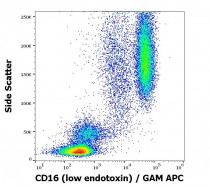ARG65489
anti-CD16 antibody [MEM-154] (low endotoxin)
anti-CD16 antibody [MEM-154] (low endotoxin) for Flow cytometry,Functional study,Immunoprecipitation,Western blot and Human
Overview
| Product Description | Azide free and low endotoxin Mouse Monoclonal antibody [MEM-154] recognizes CD16 |
|---|---|
| Tested Reactivity | Hu |
| Tested Application | FACS, FuncSt, IP, WB |
| Specificity | The antibody MEM-154 reacts with an extracellular epitope on CD16 antigen that is residing in proximity to FG loop (probably BC or C'E loop). CD16 is a low affinity receptor for aggregated IgG (FcgammaRIII antigen). The antibody MEM-154 reacts with CD16+ granulocytes. |
| Host | Mouse |
| Clonality | Monoclonal |
| Clone | MEM-154 |
| Isotype | IgG1 |
| Target Name | CD16 |
| Antigen Species | Human |
| Immunogen | Human granulocytes. |
| Conjugation | Un-conjugated |
| Alternate Names | FCRIIIA; FcRIIIa; CD antigen CD16a; Fc-gamma RIII-alpha; FCR-10; FcR-10; FCRIII; FCG3; Low affinity immunoglobulin gamma Fc region receptor III-A; FCGRIII; CD16; Fc-gamma RIIIa; IgG Fc receptor III-2; IMD20; CD16A; IGFR3; CD16a antigen; FCGR3; FcRIII; Fc-gamma RIII |
Application Instructions
| Application Suggestion |
|
||||||||||
|---|---|---|---|---|---|---|---|---|---|---|---|
| Application Note | * The dilutions indicate recommended starting dilutions and the optimal dilutions or concentrations should be determined by the scientist. |
Properties
| Form | Liquid |
|---|---|
| Purification | Purification with Protein A. |
| Purification Note | 0.2 µm filter sterilized. Endotoxin level is <0.01 EU/µg of the protein. |
| Buffer | PBS |
| Concentration | 1 mg/ml |
| Storage Instruction | For continuous use, store undiluted antibody at 2-8°C for up to a week. For long-term storage, aliquot and store at -20°C or below. Storage in frost free freezers is not recommended. Avoid repeated freeze/thaw cycles. Suggest spin the vial prior to opening. The antibody solution should be gently mixed before use. |
| Note | For laboratory research only, not for drug, diagnostic or other use. |
Bioinformation
| Database Links |
Swiss-port # P08637 Human Low affinity immunoglobulin gamma Fc region receptor III-A |
|---|---|
| Gene Symbol | FCGR3A |
| Gene Full Name | Fc fragment of IgG, low affinity IIIa, receptor (CD16a) |
| Background | This gene encodes a receptor for the Fc portion of immunoglobulin G, and it is involved in the removal of antigen-antibody complexes from the circulation, as well as other other antibody-dependent responses. This gene (FCGR3A) is highly similar to another nearby gene (FCGR3B) located on chromosome 1. The receptor encoded by this gene is expressed on natural killer (NK) cells as an integral membrane glycoprotein anchored through a transmembrane peptide, whereas FCGR3B is expressed on polymorphonuclear neutrophils (PMN) where the receptor is anchored through a phosphatidylinositol (PI) linkage. Mutations in this gene have been linked to susceptibility to recurrent viral infections, susceptibility to systemic lupus erythematosus, and alloimmune neonatal neutropenia. Alternatively spliced transcript variants encoding different isoforms have been found for this gene. [provided by RefSeq, Jul 2008] |
| Function | Receptor for the Fc region of IgG. Binds complexed or aggregated IgG and also monomeric IgG. Mediates antibody-dependent cellular cytotoxicity (ADCC) and other antibody-dependent responses, such as phagocytosis. [UniProt] |
| Cellular Localization | Cell membrane; Single-pass type I membrane protein. Secreted. Note=Exists also as a soluble receptor. [UniProt] |
| Calculated MW | 29 kDa |
| PTM | Glycosylated. Contains high mannose- and complex-type oligosaccharides. Glycosylation at Asn-180 is mandatory for high affinity binding to the Fc and for discrimination between fucosylated and afucosylated IgG glycoforms. The soluble form is produced by a proteolytic cleavage. [UniProt] |
Images (2) Click the Picture to Zoom In
-
ARG65489 anti-CD16 antibody [MEM-154] (low endotoxin) FACS image
Flow Cytometry: Human peripheral blood stained with ARG65489 anti-CD16 antibody [MEM-154] (low endotoxin) at 2 µg/ml dilution, followed by APC-conjugated Goat anti-Mouse antibody.
-
ARG65489 anti-CD16 antibody [MEM-154] (low endotoxin) FACS image
Flow Cytometry: Separation of Human neutrophil granulocytes (red-filled) from CD16 negative lymphocytes (black-dashed). Human peripheral whole blood stained with ARG65489 anti-CD16 antibody [MEM-154] (low endotoxin) at 2 µg/ml dilution, followed by APC-conjugated Goat anti-Mouse antibody.
Clone References









